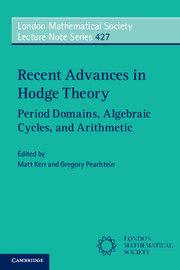Book contents
- Frontmatter
- Contents
- Preface
- Introduction
- List of Conference Participants
- Frontispiece
- PART I HODGE THEORY AT THE BOUNDARY
- (I.A) PERIOD DOMAINS AND THEIR COMPACTIFICATIONS
- (I.B) PERIOD MAPS AND ALGEBRAIC GEOMETRY
- 4 Deformation theory and limiting mixed Hodge structures
- 5 Studies of closed/open mirror symmetry for quintic threefolds through log mixed Hodge theory
- 6 The 14th case VHS via K3 fibrations
- PART II ALGEBRAIC CYCLES AND NORMAL FUNCTIONS
- PART III THE ARITHMETIC OF PERIODS
5 - Studies of closed/open mirror symmetry for quintic threefolds through log mixed Hodge theory
from (I.B) PERIOD MAPS AND ALGEBRAIC GEOMETRY
Published online by Cambridge University Press: 05 February 2016
- Frontmatter
- Contents
- Preface
- Introduction
- List of Conference Participants
- Frontispiece
- PART I HODGE THEORY AT THE BOUNDARY
- (I.A) PERIOD DOMAINS AND THEIR COMPACTIFICATIONS
- (I.B) PERIOD MAPS AND ALGEBRAIC GEOMETRY
- 4 Deformation theory and limiting mixed Hodge structures
- 5 Studies of closed/open mirror symmetry for quintic threefolds through log mixed Hodge theory
- 6 The 14th case VHS via K3 fibrations
- PART II ALGEBRAIC CYCLES AND NORMAL FUNCTIONS
- PART III THE ARITHMETIC OF PERIODS
Summary
ABSTRACT. We correct the definitions and descriptions of the integral structures in [30]. The previous flat basis in [ibid] is characterized by the Frobenius solutions and is integral in the first approximation by mean of the graded quotients of monodromy filtration, but it is not integral in the strict sense. In this article, we use integral structure of Iritani in [7] for A-model. Using this precise version, we study open mirror symmetry for quintic threefolds through log mixed Hodge theory, especially the recent result on Néron models for admissible normal functions with non-torsion extensions in the joint work [14] with K. Kato and C. Nakayama. We understand asymptotic conditions as values in the fiber over a base point on the boundary of Slog.
Introduction
In a series of joint works with K. Kato and C. Nakayama, we are constructing a fundamental diagram which consists of various kind of partial compactifications of classifying space of mixed Hodge structures and their relations.We try to understand mirror symmetry in this framework of the fundamental diagram. In this paper, we first complete the insufficient results 3.5–3.6 in the previous paper of Usui [30] (see Remark in 2.6 below), and then study open mirror symmetry for quintic threefolds through log mixed Hodge theory, especially the fine moduli of log Hodge structures and Néron models over it.
Fundamental Diagram
For a classifying space D of Hodge structures of specified type, we have
(Γ is a monodromy group) in pure case: [15], [16], [17]. For mixed case, we should extend to an amplified diagram: [9], [10], [12], [13], continuing.
Mirror symmetry for quintic threefolds
Let V be a quintic threefold in P4 and be its mirror family (cf. [1], Sect. 4.2). For simplicity, we denote the family simply by V°. if there would be no confusions.
- Type
- Chapter
- Information
- Recent Advances in Hodge TheoryPeriod Domains, Algebraic Cycles, and Arithmetic, pp. 134 - 164Publisher: Cambridge University PressPrint publication year: 2016



